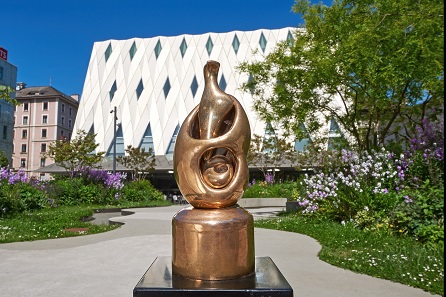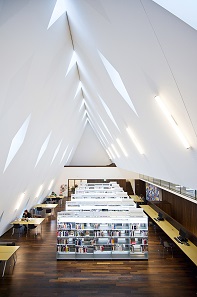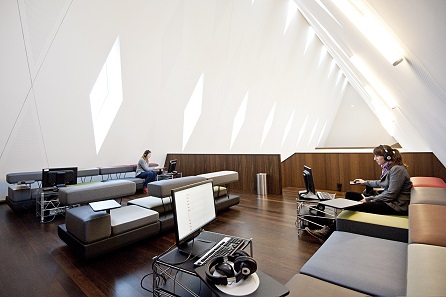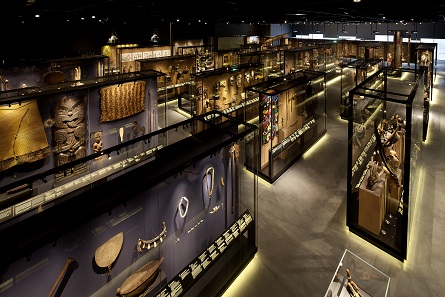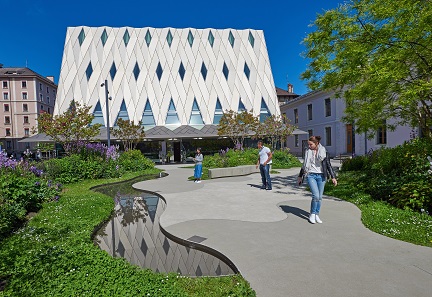August 10, 2017 – In May, the ceremony for the “European Museum of the Year Award 2017” –EMYA 2017 – was held in Zagreb, in Croatia. This is given every year to a European museum in recognition of the exceptional quality of its cultural programme for the public and its significant influence in the museum field on a national and international level. Moreover 2017 is an important year for the European Museum Forum which awards this prize as it is celebrating its 40th year of existence. This year the Musée d’ethnographie de Genève (MEG) has won this prestigious award.
For one year Henry Moore’s sculpture The Egg will remain at the MEG as a sign of the award won in 2017. Photo: © MEG / Jonathan Watts.
Nominated along with 45 other museums, the MEG has won the EMYA 2017, the highest distinction. On the European level, the Musée des Confluences in Lyon, the Musée national Picasso in Paris, the Messner Corones Mountain Museum in Italy and the National Gallery in Bulgaria were in competition. On the national level, the museums competing for the award were the Burg Museum in Zug, the Rathaus Sempach and the Besuchszentrum Schweizerische Vogelwarte also in Sempach.
Boris Wastiau, the director of the MEG, attended the award giving ceremony to receive the EMYA trophy, The Egg, a sculpture by the British artist Henry Moore, which the museum has the privilege of keeping for a year.
The EMYA is the most important award for a museum in Europe. It is presented every year by the European Museum Forum, under the auspices of the Council of Europe. Founded in 1977 by the journalist Kenneth Hudson, its aim is to acknowledge excellence in the European museum field and to encourage innovative processes in the contemporary museographical world. This award concerns all types of museums.
As every year, this distinction is awarded to a museum which has endeavoured to attract a wide public and to satisfy its visitors through a unique atmosphere, an innovative presentation of exhibitions, a creative approach to cultural mediation and social responsibility, as well as a commitment to its public and to raising its level of awareness. The museums of the 47 countries members of the Council of Europe can take part in the competition if they have been newly opened or have recently undergone alterations.
The Marie Madeleine Lancoux Library at the MEG. Photo: © Blaise Glauser.
Past winners have helped to improve the standards of quality in European museums. The Olympic Museum in Lausanne (1995), the Guggenheim Museum in Bilbao (2000), the Victoria and Albert Museum in London (2003) and the Rijksmuseum in Amsterdam (2015) are among the award-winning museums.
Boris Wastiau, the director of the MEG, is delighted with this distinction: “It was with a great deal of emotion and a certain pride that I received in Zagreb a version of ‘the Egg’ by Henry Moore, the trophy of the prestigious international EMYA. It rewards the excellent work of the MEG’s many collaborators who in recent years have succeeded in organizing exhibitions and cultural activities whose ambition and diversity are unprecedented in the museum’s history.
The music lounge. Photo: © MEG / Jonathan Watts.
Since its opening, the MEG has striven to be a place of possibilities, a museum which the public can make its own, an outward-looking place for encounters, with the objects, the collections, their history and the cultures which produced them, but also between visitors and the bearers of culture.
The exhibition “The Archives of Human Diversity”. Scenography Atelier Brückner, Stuttgart. Photo: © Daniel Stauch.
The MEG’s success is that of a museum which, in its desire to be cosmopolitan, relates to everyone, whatever their culture. With this public, we together daily build and develop the shared values of openness, respect and benevolence, as well as the will to learn and know about the diversity of societies, arts and cultures. In this we count on the collaboration of a growing number of partners, in Geneva and elsewhere, both for exhibitions and for our cultural programmes and activities in the realm of social responsibility. It is also thanks to them that we have been awarded this prize. Since the MEG was opened at the end of October 2014, the number of visitors has been steadily growing. In 2016, the exhibitions attracted more than 200,000 visitors and 38,000 took part in activities outside the exhibitions in the same year. And I wager that we have yet to reach our cruising speed and the limits of our development!”.
The exhibition “The Archives of Human Diversity”. Sound cabin. Artistic director: Ange Leccia. Photo: © Daniel Stauch.
Founded in 1901, the MEG’s aim was provide the public with a place to learn about the arts and cultures of so-called exotic societies. Since then, the collections have been enriched with objects from European peasant societies, making the MEG a real museum of world cultures. Today, almost 70,000 objects, collections of photographs, iconography and sound and music recordings are kept at the MEG.
The new MEG building. Bureau Graber Pulver Architekten AG, Zurich. Photo: © Blaise Glauser.
Since October 2014, the MEG’s treasures have been shown to advantage in a new building designed by the Zurich firm Graber Pulver Architekten AG, at 65 Bd Carl-Vogt, a site the institution has occupied since 1941. A new scenography and museography for the enhancement of its permanent exhibition “The Archives of Human Diversity” were developed with the Atelier Brückner, based in Stuttgart. This presents the collections’ unique history, while the temporary collections deal with anthropological themes connected with present day or ancient civilizations. The MEG’s big new temporary exhibition “The Boomerang Effect. The Aboriginal Arts of Australia” will be presented to 7 January 2018. It will reveal the dynamics of the political commitment of indigenous artists in the 20th and 21st centuries.
Workshop for children. Photo: © MEG / Jonathan Watts.
With an approach designed to include the public and supportive commitment part of all its activities, the MEG is today recognized for the diversity of the cultural programme accompanying its exhibitions. The pluri-disciplinary strategy at the heart of its programmes gives priority to most contemporary forms of artistic expression such as dance, performances, mapping, installations, music, films or lectures without forgetting traditional or unconventional visits and participant workshops for all kinds of visitors. This rich programme is only possible thanks to the many partnerships the MEG has managed to create since its opening with the sociocultural actors of the region and elsewhere. Since it reopened the MEG has encountered growing success, with a total for 2016 of nearly 210,000 admissions, that is seven times more than the yearly average of the former museum.
You can find more information on museum on the MEG website.
Atelier Brücker presents its projects on this website.



